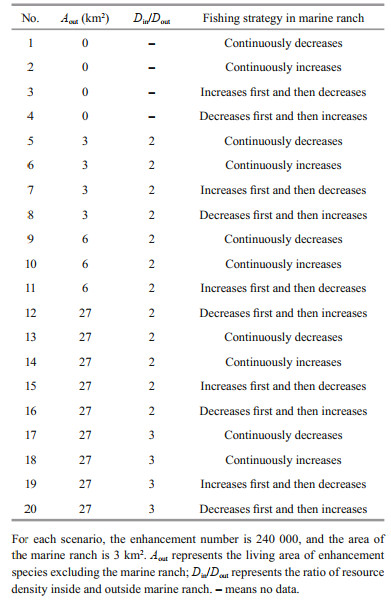Institute of Oceanology, Chinese Academy of Sciences
Article Information
- WANG Yingbin, ZHANG Wei
- Maximum sustainable yield estimation of enhancement species with the characteristics of movement inside and outside marine ranching
- Journal of Oceanology and Limnology, 39(6): 2380-2387
- http://dx.doi.org/10.1007/s00343-020-0288-y
Article History
- Received Jul. 25, 2020
- accepted in principle Oct. 9, 2020
- accepted for publication Dec. 2, 2020
In the second half of the 20th century, China's offshore capture fisheries developed rapidly. As a result, China has become the largest fishery producer and aquatic product trading country in the world. At the same time, overfishing and the deterioration of the fishing ground environment have resulted in the degradation of the offshore fishery resources in China (Zhang et al., 2003). Following some countries and regions with developed fisheries, in recent years, China has also started the research and development of technologies for artificial habitat construction, aquatic biology behavioral control, and environmental monitoring, and has established a stock enhancement and aquaculture industry that can sustainably supply high-quality aquatic products. One of the successful forms of such a technology is the construction of marine ranches (Zhang et al., 2003).
Marine ranching refers to the fishery mode that can increase the conservation of fishery resources, improve the marine ecological environment, and achieve the sustainable utilisation of fishery resources. These can be achieved by constructing or repairing sites required for reproduction, growth or feeding in specific sea areas through placing artificial reefs and releasing based on the principles of the marine ecosystem (General Office of Shandong Provincial People's Government, 2019). Through human intervention, fishery resources in marine ranches can be concentrated and utilised sustainably, which is one of the goals of marine ranch construction and management and is a concern of managers and resource scientists.
Marine ranching activities can be traced back to more than a century ago (Liao, 1997; Liao et al., 2003). Ever since, stock enhancement has been attempted at some level in over 25 countries worldwide (Bartley, 1999) with more than 100 species (fish, crustaceans, molluscs, and other invertebrates) (Liao, 1999; Fushimi, 2001). In-depth studies on marine ranching were conducted in the early 21st century and focused on juvenile releasing techniques (Fushimi, 2001; Junio-Meñez et al., 2002; Yamamoto and Morioka, 2002), released species health management (Buchmann et al., 2001), tagging methods (Brennan et al., 2002a, b), and ecological and genetic diversity (Tseng et al., 2001; Miller and Walters, 2004). Scholars in China have also carried out considerable research on the assessment of the conservation and enhancement effects of marine ranching resources. In Zhangzi Island, the investigation and evaluation of fishery resources in marine ranches and the comparison of species within and outside reef areas have shown that artificial reefs have a good conservation effect on fishery resources (Wang et al., 2018). The evaluation of the conservation effect on fishery resources in marine ranches in Xiangshan Port illustrates that the species richness, total biomass, and abundance increased after artificial reefs were installed (Wang et al., 2019b). The results of the assessment of the fishery resource enhancement effect of marine ranching in Zhelin Bay in the eastern Guangdong Province depict that fishery habitats have improved and the catch per unit of effort (CPUE) has increased (Wang et al., 2019a). Recent reports have proposed strategies for the principles and techniques of the conservation of resources in marine ranches in China (Zhang et al., 2020). Although these studies have focused on the sustainable utilisation of fishery resources in marine ranching, they do not involve the quantitative analysis of the development and management of important species, which is one of the issues of concern of the experts in this field.
The surplus production model (SPM) is one of the most important fishery stock assessment models used for estimating the annual sustainable catch of the objective species (Punt, 2003). When both the habitat water and fishing water for the target species are limited to the marine ranch, the traditional SPM can be used to estimate the maximum sustainable yield (MSY) of the species in it. However, after the implementation of stock enhancement, the MSY of the enhancement species cannot be effectively estimated using the traditional SPM. Wang (2021) proposed an enhancement SPM for the estimation of the MSY for enhancement species settled in marine ranches. However, this enhancement SPM is unsuitable for species that migrate inside and outside marine ranches; such migratory behaviour is highly common for fish living in the sea areas of marine ranches. The migration of fish inside and outside marine ranches will affect the assessment results of MSY, especially when the living area outside a marine ranch is large. At the same time, the implementation of stock enhancement also increases the complexity of the stock assessment. In this research, a new model for describing the biomass change of the enhancement species migrating inside and outside marine ranches was proposed based on the enhancement SPM, which can be used to estimate the MSY of the species that is released to marine ranch but migrate inside and outside of it. The comparison between the proposed model and the enhancement SPM were also made.
2 MATERIAL AND METHOD 2.1 ModelWang (2021) established a discrete nonequilibrium SPM for enhancement species based on the logistic biomass growth model (here, we call this model the enhancement model). The general form of biomass changes, which is the theoretical basis of the model, is
 (1)
(1)where Bt is the biomass in year t, r is the intrinsic rate of growth, e is the effective enhancement rate, St is the enhancement biomass in year t, K is the carrying capacity and Ct represents the catch in year t. This model can be used to estimate the MSY of the species settled in a marine ranch under the influence of stock enhancement. Given that, the movement range of this species usually does not exceed the boundary of the marine ranch, and the living area of the species is consistent with their fishing seas. In this way, the estimated MSY for such a species will be highly accurate. However, in addition to settled species, species with strong swimming capability will be released into the marine ranch. The movement range of these species is not limited within the marine ranch. For example, the movement range of some fish may exceed several times the area of the ranch. Equation 1 will not be a good choice for the estimation of the MSY of such a species.
When the movement range of the enhancement species exceeds the boundary of a marine ranch, the individuals inside and outside the marine ranch can be treated separately. Suppose that the movement ranges inside and outside the marine ranch are Ain and Aout, respectively, and the ratio of the resource density inside and outside the marine ranch is equal to τ (usually τ > 1 considering the effect of fish collection due to the construction of artificial habitats in the marine ranch). Based on Eq.1, the changes in the biomass inside and outside the marine ranch can be expressed by using the following equations:
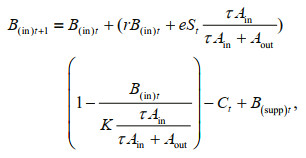 (2)
(2)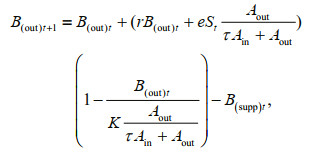 (3)
(3)where 

 (4)
(4)By adding Eqs.2 & 3 together, we can obtain Eq.5, which is suitable for the biomass change of enhancement species with the characteristics of migration inside and outside marine ranches (migration enhancement biomass model):
 (5)
(5)The parameters r, q, K, Bt (when t is the initial year) and e are estimated by using the observation error method, and then MSY can be calculated.

where CPUEt is the catch per unit of effort in year t; Et is the fishing effort in year t; q is catchability; εt represents the error and follows a normal distribution N(0, σ2), the parameter σ came from the actual observations data in the past few years, and was equal to 10%. After obtaining the parameter values, the MSY of the enhancement species in a marine ranch can be calculated by using the following equation:
 (6)
(6)The specific derivation of Eq.6 can be found in Wang (2021).
2.2 Simulation analysesIn the simulation analyses, 20 scenarios were assumed to compare the impacts of different factors on the enhancement model and migration model (Table 1). Three impact factors were considered, including (1) the living area of the enhancement species, (2) the difference of resource densities inside and outside marine ranch, and (3) the fishing strategy in marine ranch. For the first factor, the living area of enhancement species excluding the marine ranch (Aout) was used; for the second factor, the ratio of resource density inside and outside marine ranch (Din/Dout) was used; for the third factor, we assumed four change trends of catch in the marine ranch, namely annual catch continuously decrease, annual catch continuously increase, annual catch increase first then decrease, and annual catch decrease first then increase (Table 1). For each scenario, Eq.1 (enhancement model) and Eq.5 (representing the new model, which we call the migration model) were used to estimate MSY to analyse the differences between the two models. The MSY estimation was repeated 1 000 times.
Compared with the enhancement model (Eq.1), the migration model (Eq.5) proposed in this research has two more variables, i.e., the movement ranges inside and outside the marine ranch (Ain and Aout). At the same time, the original initial biomass B0 is replaced by the initial biomass inside and outside the marine ranch, i.e. B(in)0, B(out)0 and B0=B(in)0+B(out)0.
The curves of the migration model are similar to those of the enhancement model. The growth curves for the total biomass and the biomass inside and outside the marine ranch are all S-shaped (Fig. 1). The relationship between continuous yield and biomass is parabolic and is affected by stock enhancement. Consistent with the report by Wang (2021), yield is still present even when the biomass is zero (Fig. 2).
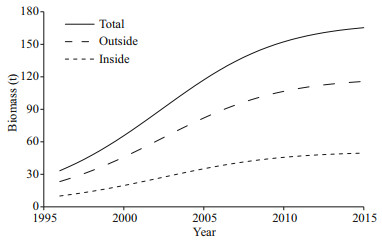
|
| Fig.1 Schematic of the biomass change trend for the migration enhancement biomass model |
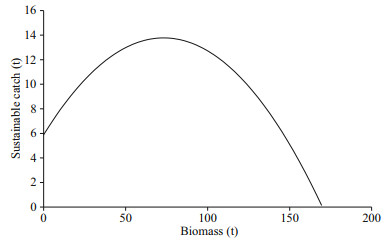
|
| Fig.2 Schematic of the sustainable yield for the migration enhancement biomass model |
Under different simulation scenarios, the MSY is underestimated by the enhancement model (Table 2). The size of the movement range outside the marine ranch has great effect on the enhancement model. As the movement range outside the marine ranch increases, the absolute value of the relative estimation error (REE) of the estimated MSY also increases. For the migration model, it is not sensitive to the movement range outside the marine. Different fishing strategies have different effects on the MSY estimation. Generally, when the catch continuously increases, the MSYs are underestimated, and for other three fishing strategies the MSYs are overestimated. When the catch decreases first and then increases, the error of the estimated MSY is relatively small. When the catch continuously increases, the estimated MSY differs greatly from the true value. When the proportion of movement range outside the marine ranch increases, the MSY estimated by using the migration model is more accurate than that estimated by using the enhancement model.
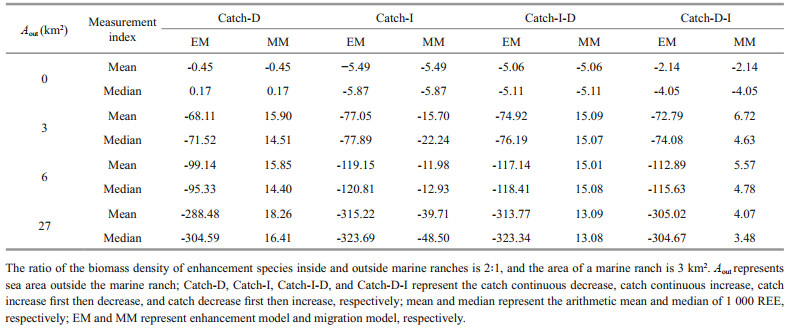
|
Given the construction of marine ranches, the density of the enhancement species inside marine ranches will be higher than that outside. When the biomass density ratio of the enhancement species inside a marine ranch to that outside increases from 2:1 to 3:1, the error of the estimated MSY increases (Tables 2 & 3). The distribution of 1 000 MSY values of the enhancement species estimated using the migration model indicates its advantages when the resource density of the target sepcies in the marine ranch is high and the living area outside the ranch is large (Supplementary Figs.S1 & S2).
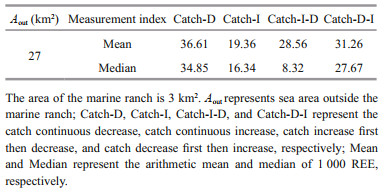
|
The structure of the migration model proposed in this study is similar to that of the enhancement model. However, because it is not only affected by stock enhancement but also by the biomass and migration of the enhancement species inside and outside marine ranches, the migration model is more complex than the enhancement model. The enhancement model contains five parameters (r, K, Bt, q, and e), whereas the migration model contains one more parameter than the enhancement model (that is, Bt is divided into B[in]t and B[out]t) because it treats the inside and outside areas of marine ranches as independent sea areas. In addition, when using the migration model, we should provide the preliminary estimate of the movement range of the enhancement species and the area of the marine ranch. Although its parameters have been increased, the migration model can address the changes in the biomass inside and outside marine ranches separately in one model. If the enhancement species move inside and outside marine ranches, a recruitment mechanism will form between these two areas. When fishing occurs within a marine ranch, the unfished stock outside the marine ranch will be recruited into the marine ranch; this trend maintains the ratio of resource densities inside and outside the marine ranch at the initial level. Although a recruitment trend for the enhancement species inside and outside the marine ranch is observed, it is not as regular as the trend described above because the movement of the enhancement species exhibits randomness. Equation 5 provides a way to estimate the MSY of the enhancement species that migrates inside and outside marine ranches.
In fact, the ratio of the biomasses of the enhancement species and the ratio of the carrying capacity (K) inside and outside marine ranches in Eqs.2, 3, & 5 can be set in accordance with the specific situation. In this study, the ratio is set based on the movement range areas of the enhancement species inside and outside marine ranches, whose resource densities are used as the weight coefficients. In practical applications, the researcher should provide initial estimates of the ratios of the area and resource density of the enhancement species inside and outside marine ranches in line with actual conditions through surveys or historical data.
As inferred from the simulation analysis results of the enhancement model and migration model, when fishing only occurs within the marine ranch, and the living area of the enhancement species does not exceed the boundaries of the marine ranch, the enhancement model and migration model are exactly the same. Thus, both models can be used to estimate the MSY of the enhancement species. As the movement range of enhancement species outside the marine ranch increases, the advantages of the migration model become increasingly obvious (Table 2 and Supplementary Fig.S1).
There are few reports on the estimation of MSY of enhancement species in marine ranch, and only Wang (2021) proposed an enhancement SPM for the estimation of the MSY for enhancement species settled in marine ranches. In the current study, we compared the results of enhancement model and migration model when dealing with the situation that enhancement species can migrate inside and outside the marine ranch. The results showed that the migration model is more suitable for the enhancement species that migrate inside and outside the marine ranch than the enhancement model. When the Aout=0, the estimated MSY of the two models are exactly the same. When Aout > 0, the enhancement model only considers the enhancement individuals inside the marine ranch, and does not deal with those outside the marine ranch. When the movement range of the enhancement species outside marine ranch becomes large, the consistency between the fishing area inside the marine ranch and the living area of the enhancement species becomes poor. Using the enhancement model is equivalent to estimating the biomass in the entire movement range based on only the catch data in the marine ranch, indicating that the representativeness of the fishing information is very low. Thus, it may underestimate the MSY. The improvement of the proposed migration model over the enhancement model is that it extends the scope of application beyond marine ranch by introducing the ratio of the resource density (τ) and treating the individuals inside and outside the marine ranch separately (Eqs.2, 3, & 5). Therefore, the estimated MSYs of migration model are better than those of enhancement model when the proportion of movement range outside the marine ranch increases (Table 2).
Although the migration model is appropriate to the migration characteristics of the enhancement species inside and outside marine ranch, it has a tendency to overestimate the results, especially when the movement range of enhancement species outside the marine ranch increases. There may be many reasons for the overestimation. First, given that the enhancement species can move freely inside and outside marine ranches, the MSY of the enhancement species in a marine ranch and the MSY in the entire living area should be similar, i.e., the resources that are reduced because of capture in the marine ranch can be recruited from outside the ranch. Therefore, the catchability coefficient (q) is the critical parameter for stock assessment for a large-scale sea area based on the catch data in marine ranches. q represents the proportion of the biomass of the target species to the total biomass in a certain sea area caught by one unit of effort. In theory, as long as the value of q can be accurately determined, a viable MSY can be estimated. However, when fishing only occurs in marine ranch, and at the same time the resource density in the marine ranch is higher than that outside, q is prone to be overestimated, which will lead to the overestimation of MSY. Second, the parameter value of e may also be overestimated since the survival rate of the enhancement species maybe high benefit from the recruitment from outside the marine ranch and the protective effects of artificial reefs, etc. Third, the division of carrying capacity (K) and enhancement biomass (S) inside and outside marine ranch is based on the resource density and area (Eqs.2 & 3), which is a mathematical approach we had to use since the field monitoring data was unavailable. Fourth, the recruitment biomass (Bsupp) lacks a specific calculation formula, which may also be a source of error in overestimating MSY. All of the above issues are needed to be studied in depth in future research.
The difference in the resource density of the enhancement species inside and outside marine ranches can also affect the MSY estimation results. Great differences provide poor estimation results. A large difference in density means that the homogeneity of resource distribution inside and outside a marine ranch is poor, which inevitably affects the randomness of the migration of the enhancement species inside and outside the marine ranch. When fishing occurs in the marine ranch, ensuring that the ratio of resource densities inside and outside the marine ranch remains at the original level becomes difficult even though resources may be recruited into the marine ranch from the outside. If the resource densities inside and outside the marine ranch are similar, maintaining the consistency of the resource density through resource migration, which can also improve the accuracy of the estimation of MSY, is easy.
In 1998, Hannesson proposed a biomass variation model based on the migration characteristics of fish inside and outside marine reserves (Hannesson, 1998). A parameter of the migration rate of the stock in the marine reserve is introduced into this model. Subsequently, some scholars applied the concept of migration rate in the study of the sustainable yield of fishery resources in protected marine areas (and sea areas where fishing operations cannot be performed due to special reasons) (Pincin and Wilberg, 2012; Shibata et al., 2015; Paul et al., 2018). In contrast to marine protected areas, marine ranches are artificial fishing grounds (Shandong Provincial Oceanic and Fishery Department, 2017) and are a service provided for the sustainable utilisation of fishery resources. Therefore, fishing operations occur within marine ranches. However, fishing behaviour is usually restricted in marine ranches and is forbidden in surrounding sea areas to protect resources from being overexploited. The concept of migration rate can also be applied in the study of the dynamics of fishery resources inside and outside marine ranches. However, determining the actual migration rate of the target species is difficult. Techniques, such as marking or underwater observation, can be used for the estimation of migration rate, and their results are usually subject to large errors. Therefore, we did not use the parameter of migration rate in the current study but instead added variables representing the areas and the original biomasses inside and outside a marine ranch to the model. These variables can be obtained through routine surveys and are easy to acquire.
In the current study, a migration enhancement biomass model for an enhancement species is proposed based on the movement ranges and density ratios of the target species inside and outside marine ranches. It provides an idea of estimating the MSY of the target species for similar situations. The application of this model is not limited to marine ranch. The model can be used to estimate the MSY of an enhancement species when the sea area for its fishing operation is inconsistent with its living area. Moreover, the accuracy of the results estimated by this model is higher than that of the results estimated by the enhancement model. The parameters in the model can be adjusted in accordance with the actual situation to meet the characteristics of resource migration and distribution, thereby improving the accuracy of stock assessment.
5 CONCLUSIONThe migration enhancement biomass model proposed in this study can be used to estimate the MSY of the enhancement species with migration characteristics inside and outside marine ranches. The MSY is prone to be overestimated, and movement range ratios and biomass density inside and outside marine ranches are two important parameters that can affect the accuracy of the estimation results. The proposed model also provides an idea for estimating the MSY of species with inconsistent living and fishing areas.
6 DATA AVAILABILITY STATEMENTThe data that support the findings of this study are available from the corresponding author upon reasonable request.
7 ACKNOWLEDGMENTWe are grateful for all scientific staff and crew for their assistance with data collection during all the surveys.
Electronic supplementary material
Supplementary material (Supplementary Figs.S1–S2) is available in the online version of this article at https://doi.org/10.1007/s00343-020-0288-y.
Bartley D M. 1999. Marine ranching: a global perspective. In: Howell B R, Moskness E, Svåsand T eds. Stock Enhancement and Sea Ranching. Fishing News Books, Oxford. p. 79-90.
|
Brennan N P, Blackburn B R, Blakenship H L, Leber K M, DeBruler R Jr. 2002a. Retention of CWT and VIE tags, and in situ assessment of the VIE tags in juvenile red snapper, Lutjanus campechanus, stocked on artificial reefs (Abstract). Paper presented during the Second International Symposium on Stock Enhancement and Sea Ranching. Kobe, Japan. p. 123.
|
Brennan N P, Skelton H, Leber K M, DeBruler R Jr, Blackburn B, Fritz V. 2002b. A field comparison of T-bar and visible implant elastomere tags with the common snook, Centropomus undecimalus (Abstract). Paper presented during the Second International Symposium on Stock Enhancement and Sea Ranching. Kobe, Japan. p. 124.
|
Buchmann K, Larsen J L, Therkildsen B. 2001. Improved recapture rate of vaccinated sea-ranched Atlantic salmon, Salmo salar L. Journal of Fish Diseases, 24(4): 245-248.
DOI:10.1046/j.1365-2761.2001.00294.x |
Fushimi H. 2001. Production of juvenile marine finfish for stock enhancement in Japan. Aquaculture, 200(1-2): 33-53.
DOI:10.1016/s0044-8486(01)00693-7 |
General Office of Shandong Provincial People's Government. 2019. Comprehensive pilot scheme for the construction of modern marine ranches in Shandong Province. http://www.shandong.gov.cn/art/2019/1/16/art_2259_30443.html. Accessed on 2019-01-14. (in Chinese)
|
Hannesson R. 1998. Marine reserves: what would they accomplish?. Marine Resource Economics, 13(3): 159-170.
DOI:10.1086/mre.13.3.42629231 |
Junio-Meñez M A, Bangi H G P, Malay M C D. 2002. Enhancement of Tripneustes gratilla populations in Pangasinan, northwestern Philippines (Abstract). Paper presented during the Second International Symposium on Stock Enhancement and Sea Ranching. Kobe, Japan. p. 65.
|
Liao I C, Su M S, Leaño E M. 2003. Status of research in stock enhancement and sea ranching. Reviews in Fish Biology and Fisheries, 13(2): 151-163.
DOI:10.1023/B:RFBF.0000019477.97551.73 |
Liao I C. 1997. How can aquaculture help sustain world fisheries? In: Hancock D A, Smith D C, Grant A, Beumer J P eds. Developing and Sustaining World Fisheries Resources: The State of Science and Management. CSIRO, Australia. p. 431-436.
|
Liao I C. 1999. How can stock enhancement and sea ranching help sustain and increase coastal fisheries? In: Howell B R, Moksness E, Svåsand T eds. Stock Enhancement and Sea Ranching. Fishing News Books, Oxford. p. 132-149.
|
Miller J M, Walters C J. 2004. Experimental ecological tests with stocked marine fish. In: Stock Enhancement and Sea Ranching: Developments, Pitfalls and Opportunities. Blackwell Publishing, Oxford. p. 142-152.
|
Paul P, Kar T K, Ghorai A. 2018. Impact of marine reserve on maximum sustainable yield in a traditional prey-predator system. Communications in Nonlinear Science and Numerical Simulation, 54: 34-49.
DOI:10.1016/j.cnsns.2017.05.013 |
Pincin J S, Wilberg M J. 2012. Surplus production model accuracy in populations affected by a no-take marine protected area. Marine and Coastal Fisheries: Dynamics, Management, and Ecosystem Science, 4(1): 511-525.
DOI:10.1080/19425120.2012.685145 |
Punt A E. 2003. Extending production models to include process error in the population dynamics. Canadian Journal of Fisheries and Aquatic Sciences, 60(10): 1217-1228.
DOI:10.1139/f03-105 |
Shandong Provincial Oceanic and Fishery Department. 2017. DB37/T 2982.3-2017 Specification for marine ranching construction Part 3: Layout and deployment. Shandong Provincial Standard. Shandong Provincial Bureau of Quality and Technical Supervision (in Chinese with English abstract)
|
Shibata Y, Yamada M, Wada T, Itou M, Yamada H, Sohtome T, Iwasaki T, Sakuma T, Mizuno T. 2015. A surplus production model considering movements between two areas using spatiotemporal differences in CPUE: application to sea ravens Hemitripterus villosus off Fukushima as a practical marine protected area after the nuclear accident. Marine and Coastal Fisheries: Dynamics, Management, and Ecosystem Science, 7(1): 325-337.
DOI:10.1080/19425120.2015.1050536 |
Tseng M C, Lee S C, Tzeng W N. 2001. Genetic variation of the Japanese eel Anguilla japonica based on microsatellite DNA. Journal of Taiwan Fisheries Research, 9(1-2): 137-147.
|
Wang H H, Bi F Y, Cao M, Tang Y. 2018. Survey and acoustic assessment of fishery resources in marine ranching area surrounding Zhangzi Island in autumn. Journal of Dalian Fisheries University, 33(6): 802-807.
(in Chinese with English abstract) DOI:10.16535/j.cnki.dlhyxb.2018.06.019 |
Wang Y B. 2021. Surplus production model of settled species based on stock enhancement and its simulation analyses. Acta Oceanologica Sinica, 43(2): 28-37.
(in Chinese with English abstract) DOI:10.12284/hyxb2021006 |
Wang Y F, Hu Q W, Yu J, Chen P M, Shu L M. 2019a. Effect assessment of fishery resources proliferation in Zhelin Bay marine ranching in eastern Guangdong. South China Fisheries Science, 15(2): 12-19.
(in Chinese with English abstract) DOI:10.12131/20180143 |
Wang Y L, Li S F, Jiang Y Z, Zhang S Y, Hu Q S, Shentu J K, Jiao H F. 2019b. Marine ranching and fishery stock enhancement in the Xiangshan Bay. Journal of Fisheries of China, 43(9): 1972-1980.
(in Chinese with English abstract) DOI:10.11964/jfc.20190611845 |
Yamamoto Y, Morioka T. 2002. Improvement of seedling quality in red sea bream, Pagrus major, for stock enhancement (Abstract). Paper presented during the Second International Symposium on Stock Enhancement and Sea Ranching. Kobe, Japan. p. 24.
|
Zhang G S, Chen Y, Zhang P D, Tian T, Liu H Y, Xu C C. 2003. Significance and feasibility of establishing marine ranching in Chinese sea area. Journal of Dalian Fisheries University, 18(2): 141-144.
(in Chinese with English abstract) DOI:10.16535/j.cnki.dlhyxb.2003.02.013 |
Zhang T, Feng J, Song H. 2020. Principles and technology of biological resources maintenance in marine ranching. Science & Technology for Development, 16(2): 206-212.
(in Chinese with English abstract) DOI:10.11842/chips.20200316003 |
 2021, Vol. 39
2021, Vol. 39



